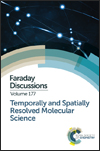Negative hyperconjugation and red-, blue- or zero-shift in X–Z⋯Y complexes†
Abstract
A generalized explanation is provided for the existence of the red- and blue-shifting nature of X–Z bonds (Z = H, halogens, chalcogens, pnicogens, etc.) in X–Z⋯Y complexes based on computational studies on a selected set of weakly bonded complexes and analysis of existing literature data. The additional electrons and orbitals available on Z in comparison to H make for dramatic differences between the H-bond and the rest of the Z-bonds. The nature of the X-group and its influence on the X–Z bond length in the parent X–Z molecule largely controls the change in the X–Z bond length on X–Z⋯Y bond formation; the Y-group usually influences only the magnitude of the effects controlled by X. The major factors which control the X–Z bond length change are: (a) negative hyperconjugative donation of electron density from X-group to X–Z σ* antibonding molecular orbital (ABMO) in the parent X–Z, (b) induced negative hyperconjugation from the lone pair of electrons on Z to the antibonding orbitals of the X-group, and (c) charge transfer (CT) from the Y-group to the X–Z σ* orbital. The exchange repulsion from the Y-group that shifts partial electron density at the X–Z σ* ABMO back to X leads to blue-shifting and the CT from the Y-group to the σ* ABMO of X–Z leads to red-shifting. The balance between these two opposing forces decides red-, zero- or blue-shifting. A continuum of behaviour of X–Z bond length variation is inevitable in X–Z⋯Y complexes.
- This article is part of the themed collection: Temporally and Spatially Resolved Molecular Science

 Please wait while we load your content...
Please wait while we load your content...